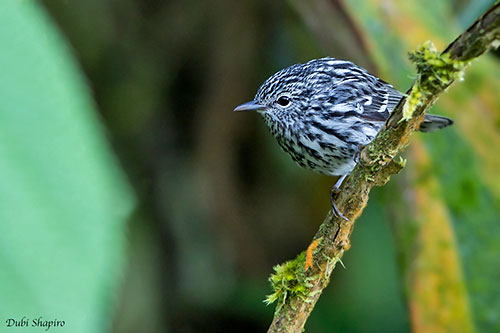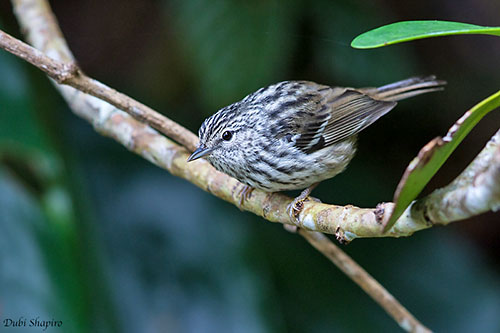
REPRODUCTION OF THIS SPECIES:
The laying usually occurs from March to June, and sometimes in November following October’s rains.
The female builds a cup-shaped nest, well-hidden in bush, tree or vines. It is made with rootlets and the cup is lined with softer material such as moss and lichens.
The female lays 2-4 white eggs with heavy dark spotting and some reddish-grey markings on the broad end.
Usually, the chicks are fed by both parents.
PROTECTION / THREATS / STATUS:
The Arrowhead Warbler is vulnerable to habitat destruction through deforestation. This species has restricted range in which it is described as locally common.
The population is suspected to be declining, but currently, the Arrowhead Warbler is not globally threatened and evaluated as Least Concern.
Fr: Paruline de la Jamaïque
Ang: Arrowhead Warbler
All: Strichelwaldsänger
Esp: Reinita Jamaicana
Ita: Parula sagittata
Nd: Jamaicazanger
Sd: jamaicaskogssångare
Photographer:
Dubi Shapiro
Dubi Shapiro Photo Galleries & Dubi Shapiro's Pictures on IBC
Text by Nicole Bouglouan
Sources:
HANDBOOK OF THE BIRDS OF THE WORLD Vol 15 by Josep del Hoyo-Andrew Elliot-David Christie - Lynx Edicions – ISBN: 9788496553682
BIRDS OF THE WEST INDIES – by Herbert Raffaele, Kristin Williams et Tracy Pedersen – Helm – ISBN: 9780713649055
A Photographic Guide to the Birds of Jamaica by Ann Haynes-Sutton, Yves-Jacques Rey-Millet, Audrey Downer, Robert Sutton – Editor: Bloomsbury Publishing, 2010. ISBN: 1408133229, 9781408133224 - 336 pages
Neotropical Birds – Cornell Lab of Ornithology
Arrowhead Warbler
Setophaga pharetra
Passeriformes Order – Parulidae Family
INTRODUCTION:
The Arrowhead Warbler is endemic to Jamaica where it frequents humid montane forest during the breeding season.
Like most Parulidae, it feeds primarily on insects by gleaning high in trees.
The Arrowhead Warbler is vulnerable to habitat destruction, but it is not currently threatened.
DESCRIPTION OF THE BIRD:
Biometrics:
Length: 12-13 cm
Weight: 9-11 g
The Arrowhead Warbler has streaked black and white plumage overall including on the head. Belly and vent are mostly whitish. On the darker upperwing, both greater and median coverts are tipped white, forming two white wingbars. The tail is dark with white-tipped outer rectrices.
The pointed bill is black. The eyes are dark brown. Legs and feet are brownish-black.

Male and female are almost similar, with the female slightly duller. She has upperwing and uppertail tinged brownish.
The juvenile lacks the streaks on the underparts.
The first year has brownish-olive upperparts with indistinct yellowish streaks and darker wings and tail. The underparts are pale brownish-yellow with faint darker streaks.
RANGE:
The Arrowhead Warbler is endemic to Jamaica. It occurs in Blue Mountains, Hardwar Gap, Cockpit Country, Mandeville and Anchovy, and at some locations on the coast such as Fern Gully and Ferry River.
HABITAT:
The Arrowhead Warbler breeds in humid forests in mountains. Outside of breeding season, it can be found in wet lowland forests but less frequently.
CALLS AND SONGS: SOUNDS BY XENO-CANTO
The Arrowhead Warbler’s common call is a high-pitched “tic” often repeated.
The very soft song is somewhat variable. It usually consists of six notes with rising last note “tswee-tswee-tswee-tswee-tswee-tswee”. This series is followed by three other similar notes ending in jumble of sounds or with three descending notes.
BEHAVIOUR IN THE WILD:
The Arrowhead Warbler is primarily an insect-eater. It feeds on a variety of insects by gleaning from vegetation, foliage and vines at all levels in trees, but more often beneath the canopy and high above the ground.
Like most Parulidae, the Arrowhead Warbler pairs for life and remains on or near the territory all year round. They defend the nest-site against intruders.
The courtship displays are not described, but this species regularly flicks the tail down.
The Arrowhead Warbler is sedentary and only performs some altitudinal movements to lowlands after breeding.
The flight is usually agile.
